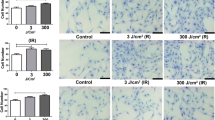Abstract
Use of the low-energy helium-neon laser (LEL) appears to be a simple atraumatic technique for the prevention and treatment of mucositis of various origins. Preliminary findings, and significant results obtained for chemotherapy-induced mucositis in a previous phase III study, prompted a randomized multicenter double-blind trial to evaluate LEL in the prevention of acute radiation-induced stomatitis. Irradiation by LEL corresponds to local application of a high-photon-density monochromatic light source. Activation of epithelial healing for LEL-treated surfaces, the most commonly recognized effect, has been confirmed by numerous in vitro studies. The mechanism of action at a molecular and enzymatic level is presently being studied. From September 1994 to March 1998, 30 patients were randomized. Technical specification: 60 mW (25 mW at Reims, 1 patient), He-Ne, wavelength 632.8 nm. The trial was open to patients with carcinoma of the oropharynx, hypopharynx and oral cavity, treated by radiotherapy alone (65 Gy at a rate of 2 Gy/fraction, 5 fractions per week) without prior surgery or concomitant chemotherapy. The malignant tumor had to be located outside the tested laser application areas (9 points): posterior third of the internal surfaces of the cheeks, soft palate and anterior tonsillar pillars. Patients were randomized to LEL or placebo light treatment, starting on the first day of radiotherapy and before each session. The treatment time (t) for each application point was given by the equation : t (s)=energy (J/cm2)×surface (cm2)/Power (W). Objective assessment of the degree of mucositis was recorded weekly by a physician blinded to the type of treatment, using the WHO scale for grading of mucositis and a segmented visual analogue scale for pain evaluation. Protocol feasibility and compliance were excellent. Grade 3 mucositis occured with a frequency of 35.2% without LEL and of 7.6% with LEL (P<0.01). The frequency of "severe pain" (grade 3) was 23.8% without LEL, falling to 1.9% with LEL (P<0.05). Pain relief was significantly reduced throughout the treatment period (weeks 2–7). LEL therapy is capable of reducing the severity and duration of oral mucositis associated with radiation therapy. In addition, there is a tremendous potential for using LEL in combined treatment protocols utilizing concomitant chemotherapy and radiotherapy.
Similar content being viewed by others
Author information
Authors and Affiliations
Additional information
Published online: 28 May 1999
Rights and permissions
About this article
Cite this article
Bensadoun, R., Franquin, J., Ciais, G. et al. Low-energy He/Ne laser in the prevention of radiation-induced mucositis . Support Care Cancer 7, 244–252 (1999). https://doi.org/10.1007/s005200050256
Issue Date:
DOI: https://doi.org/10.1007/s005200050256




